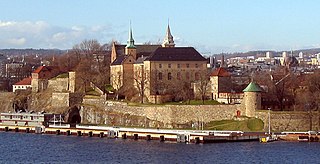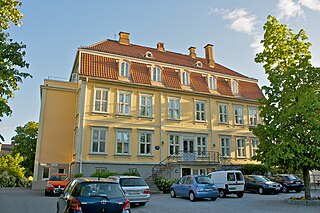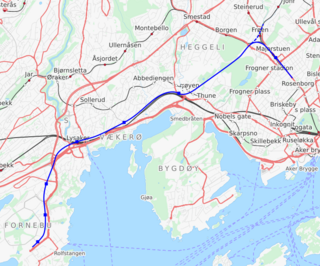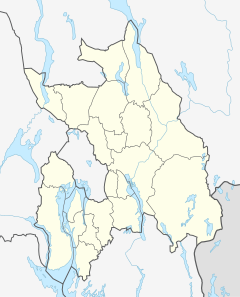
Akershus is a county in Norway, with Oslo as its administrative centre, though Oslo is not located within Akershus. Akershus has been a region in Eastern Norway with Oslo as its main city since the Middle Ages, and is named after the Akershus Fortress in Oslo and ultimately after the medieval farm Aker in Oslo. From the Middle Ages to 1919, Akershus was a main fief and main county that included most of Eastern Norway, and from the 17th century until 2020 and again from 2024, Akershus also has a more narrow meaning as a smaller central county in the Greater Oslo Region. Akershus is Norway's largest county by population with over 716,000 inhabitants.

Lillestrøm is a municipality in Akershus county. It is located in the traditional district of Romerike. With a population of 85,757 inhabitants, it is the fourth most populated municipality in Viken. It was founded on 1 January 2020 as a merger between former municipalities Fet, Skedsmo and Sørum. The administrative centre of the municipality is the town of Lillestrøm. The town of Lillestrøm is a part of the Oslo metropolitan area.

Jernbanetorget is both a rapid transit station on the Oslo Metro and a tram stop of the Oslo Tramway. The metro station is in the Common Tunnel used by all lines under the city centre. It is located between Stortinget to the west and Grønland to the east. Until the construction of the station at Stortinget, Jernbanetorget was the end station for the eastern lines in downtown. Along with the Oslo Central Station, Oslo Bus Terminal and the tram and bus station above ground, Jernbanetorget is the largest transport hub in Norway.

Majorstuen is a subway station on the Oslo Metro and a tram stop on the Briskeby Line of the Oslo Tramway. It is located in the Majorstuen neighborhood in the Frogner borough.

Frognerseteren is the end station of the Holmenkollen Line of the Oslo Metro, located in the Marka section of Oslo, the capital city of Norway. It's the northernmost station in Oslo Metro, and is the station after Voksenkollen. The line to Frognerseteren was completed on 16 May 1916. The station has two platforms which, like other stations on the Holmenkollen Line, only accommodate two-car trains. The elevation of the station is 469 meters (1,539 ft) above sea level, the highest of all the stations in Oslo. The elevation difference between this station and the lowest in Oslo Metro (Stortinget), 478 meters (1,568 ft), is the highest elevation difference within a metro network in the world.

The Trunk Line is a railway line in Norway which runs between Oslo and Eidsvoll. The line is owned by Bane NOR.

The Oslo Tunnel is a 3,632-metre (2.257 mi), double-track, railway tunnel which runs between Olav Kyrres plass and Oslo Central Station (Oslo S) in Oslo, Norway. The tunnel constitutes the easternmost section of the Drammen Line and runs below the central business district of Oslo. It features the four-track Nationaltheatret Station, Norway's second-busiest railway station, where the Oslo Tunnels lies directly beneath the Common Tunnel of the Oslo Metro. At Frogner, the Elisenberg Station was built, but has never been used. The tunnel is the busiest section of railway line in Norway and serves all west-bound trains from Oslo, including many services of the Oslo Commuter Rail and the Airport Express Train.

Frogner Park is a public park in the central West End borough of Frogner in Oslo, Norway. The park is historically part of Frogner Manor and is Oslo's largest park, open to the public at all times. It includes the manor house which is the seat of Oslo Museum, the nearby Henriette Wegner Pavilion, the Vigeland installation of sculptures created by sculptor Gustav Vigeland, Frogner Baths, Frogner stadion, Frognerparken Café, the restaurant Herregårdskroen and the largest collection of roses in the country with 14,000 plants of 150 species. Frogner Park is the most visited tourist attraction in Norway.
Elisenberg station is an unfinished railway station within the Oslo Tunnel on the Drammen Line in Oslo, Norway. The ghost station was partially built during the construction of the tunnel between 1971 and 1980, but has never been put into use. It is located between Nationaltheatret Station and Skøyen Station, at Elisenberg in Frogner. A 220-meter (720 ft) long center platform and part of the access way has been built, but never completed. While the station initially was not put into use because of lack of funds to complete it, it is now unlikely that it will ever be completed, as the need for a station has disappeared and an opening would need a large investment of funds.

Grorud Station is a railway station on the Trunk Line located in the Grorud borough of Oslo, Norway. Situated 10.50 kilometers (6.52 mi) from Oslo Central Station, it consists of three tracks with a side platforms and an island platform. Grorud is served by the L1 line of the Oslo Commuter Rail.
A/S Kristiania Elektriske Sporvei or KES, nicknamed the Blue Tramway, was a company which operated part of the Oslo Tramway between 1894 and 1924. It built a network of four lines in Western Oslo, the Briskeby Line and the Frogner Line which ran to Majorstuen, and two other consecutive lines, the Skøyen Line and the Lilleaker Line. These all connected to a common line through the city center which terminated at Jernbanetorget.

The Briskeby Line is a line of the Oslo Tramway in Norway. It runs westwards from Jernbanetorget in the city center, passing through the neighborhoods of Briskeby and Uranienborg before reaching its terminus at Majorstuen. The section from Jernbanetorget to Inkognitogata is shared with the Skøyen Line; on this section it connects with the important transport hub Nationatheatret. This part is variously served by route 11, 12 and 13. From the Inkognitogata stop, the line moves through the residential areas around the Royal Palace, in the streets named Riddervolds gate, Briskebyveien, Holtegata and Bogstadveien. The part of the line in Bogstadveien from Majorstuen to Rosenborg is also served by route 19, which operates the Homansbyen Line.

Frogner stadion is a sports stadium in Oslo, Norway, which has artificial ice in the winter for speed skating and bandy. The artificial grass is used in the summer for soccer and American football. It is located close to the Frogner Park, between the park and Majorstuen. One match, Norway-Belarus, was played here at the 2013 Bandy World Championship.

The Frogner Line is a section of the Oslo Tramway which runs between Solli and Majorstuen, serving the neighborhood of Frogner. The line is served by tram number 12, and the Frogner section makes up the westernmost part of this line. From Solli to Frogner, the line runs northwestwards to Frognerveien, then turns northeast along Kirkeveien, along the Frogner Park, including a stop at the main gate to the Vigeland sculpture installation, before ending at Majorstuen where it connects with the Homansbyen Line and Briskeby Line.
Homansbyen is a tram stop located at Homansbyen in Frogner borough of Oslo, Norway. It is on the Homansbyen Line, a short line that connects the Briskeby Line and Ullevål Hageby Line of Oslo Tramway, and is served by line 19 using SL79 trams. This line is the shortest of the three tram lines that connect the city centre with Majorstuen. The city has planned to build a new rapid transit station for the Oslo T-bane at Homansbyen, but as of 2017 this has not been developed.

Briskeby is an area in the borough Frogner in Oslo, Norway.

The Vigeland Museum is a museum dedicated to Gustav Vigeland in Frogner, Oslo. It is located outside Frogner Park, which includes the Vigeland installation with sculptures by Gustav Vigeland. The museum is part of Oslo municipality's cultural department.

Elisenberg is a tram stop on the Oslo Tramway.

Elisenberg is a neighborhood in the Frogner borough in Oslo, Norway.

The Fornebu Line is an under construction rail line which will serve the peninsula of Fornebu in Bærum, Norway. The line is under construction and the transit agency Ruter is working towards connecting it to the Oslo Metro. The line has at various stages been proposed as an automated people mover, tram-train, tramway, light rail, stadtbahn, rapid transit, bus rapid transit and commuter rail, with the rapid transit option being selected as the final proposal. The metro line will start at Majorstuen Station and will run entirely in a tunnel for 8,150 meters (26,740 ft). The line will have six stations, at Skøyen, Vækerø, Lysaker, Telenor Arena, Flytårnet and Fornebu Senter. A depot will be built at Fornebu and the line will connect to the metro's Common Tunnel at Majorstuen.


















